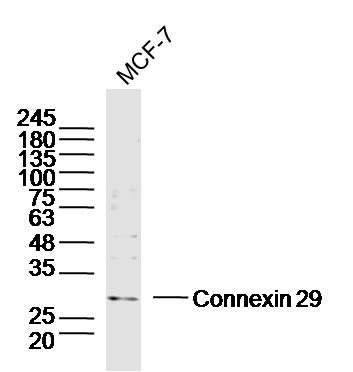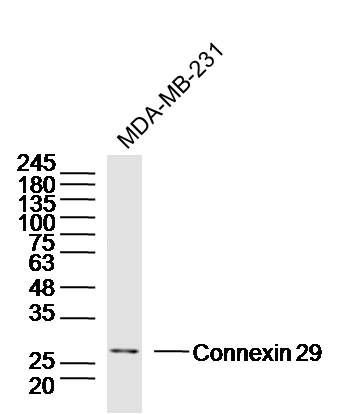Connexin 29 Polyclonal Antibody
Purified Rabbit Polyclonal Antibody (Pab)
- SPECIFICATION
- CITATIONS
- PROTOCOLS
- BACKGROUND

Application
| WB, IHC-P, IHC-F, IF, ICC, E |
|---|---|
| Primary Accession | Q8NFK1 |
| Reactivity | Rat |
| Host | Rabbit |
| Clonality | Polyclonal |
| Calculated MW | 31 KDa |
| Physical State | Liquid |
| Immunogen | KLH conjugated synthetic peptide derived from human Connexin 29 |
| Epitope Specificity | 151-250/279 |
| Isotype | IgG |
| Purity | affinity purified by Protein A |
| Buffer | 0.01M TBS (pH7.4) with 1% BSA, 0.02% Proclin300 and 50% Glycerol. |
| SUBCELLULAR LOCATION | Cell membrane. Cell junction, gap junction. |
| SIMILARITY | Belongs to the connexin family. Gamma-type subfamily. |
| SUBUNIT | A connexon is composed of a hexamer of connexins |
| Important Note | This product as supplied is intended for research use only, not for use in human, therapeutic or diagnostic applications. |
| Background Descriptions | Connexin 29 belongs to the connexin family and is a member of the epsilon-type subfamily. Connexin 29 is a membrane bound, multi-pass protein also known as gap junction epsilon-1 protein. A connexon, consisting of connexin hexamers, is a membrane bound structure that is integral in the formation of a gap junction. One gap junction consists of a cluster of closely packed pairs of transmembrane channels, the connexons, through which materials of low molecular weight diffuse from one cell to a neighboring cell. Connexin 29 expression is restricted to the central nervous system and is present in brain, spinal cord, and sciatic nerve samples. It has been suggested that connexin 29 in the mature CNS contributes minimally to gap junctional intercellular communication in oligodendrocyte cell bodies. Rather, connexin 29 is targeted to myelin where it, along with connexin 32, may contribute to connexin-mediated communication between adjacent layers of uncompacted myelin. |
| Gene ID | 349149 |
|---|---|
| Other Names | Gap junction gamma-3 protein, Connexin-30.2, Cx30.2, Connexin-31.3, Cx31.3, Gap junction epsilon-1 protein, GJC3, GJE1 |
| Target/Specificity | CNS specific. Expression is restricted to brain, spinal cord, and sciatic nerve. According to PubMed:12881038, expression is abundant in skeletal muscle, liver, and heart, and to a minor degree in pancreas and kidney. |
| Dilution | WB=1:500-2000,IHC-P=1:100-500,IHC-F=1:100-500,ICC=1:100-500,IF=1:100-500,ELISA=1:5000-10000 |
| Format | 0.01M TBS(pH7.4), 0.09% (W/V) sodium azide and 50% Glyce |
| Storage | Store at -20 ℃ for one year. Avoid repeated freeze/thaw cycles. When reconstituted in sterile pH 7.4 0.01M PBS or diluent of antibody the antibody is stable for at least two weeks at 2-4 ℃. |
| Name | GJC3 |
|---|---|
| Synonyms | GJE1 |
| Function | One gap junction consists of a cluster of closely packed pairs of transmembrane channels, the connexons, through which materials of low MW diffuse from one cell to a neighboring cell. |
| Cellular Location | Cell membrane; Multi-pass membrane protein. Cell junction, gap junction |
| Tissue Location | CNS specific. Expression is restricted to brain, spinal cord, and sciatic nerve. According to PubMed:12881038, expression is abundant in skeletal muscle, liver, and heart, and to a minor degree in pancreas and kidney. |

Thousands of laboratories across the world have published research that depended on the performance of antibodies from Abcepta to advance their research. Check out links to articles that cite our products in major peer-reviewed journals, organized by research category.
info@abcepta.com, and receive a free "I Love Antibodies" mug.
Provided below are standard protocols that you may find useful for product applications.
If you have used an Abcepta product and would like to share how it has performed, please click on the "Submit Review" button and provide the requested information. Our staff will examine and post your review and contact you if needed.
If you have any additional inquiries please email technical services at tech@abcepta.com.













 Foundational characteristics of cancer include proliferation, angiogenesis, migration, evasion of apoptosis, and cellular immortality. Find key markers for these cellular processes and antibodies to detect them.
Foundational characteristics of cancer include proliferation, angiogenesis, migration, evasion of apoptosis, and cellular immortality. Find key markers for these cellular processes and antibodies to detect them. The SUMOplot™ Analysis Program predicts and scores sumoylation sites in your protein. SUMOylation is a post-translational modification involved in various cellular processes, such as nuclear-cytosolic transport, transcriptional regulation, apoptosis, protein stability, response to stress, and progression through the cell cycle.
The SUMOplot™ Analysis Program predicts and scores sumoylation sites in your protein. SUMOylation is a post-translational modification involved in various cellular processes, such as nuclear-cytosolic transport, transcriptional regulation, apoptosis, protein stability, response to stress, and progression through the cell cycle. The Autophagy Receptor Motif Plotter predicts and scores autophagy receptor binding sites in your protein. Identifying proteins connected to this pathway is critical to understanding the role of autophagy in physiological as well as pathological processes such as development, differentiation, neurodegenerative diseases, stress, infection, and cancer.
The Autophagy Receptor Motif Plotter predicts and scores autophagy receptor binding sites in your protein. Identifying proteins connected to this pathway is critical to understanding the role of autophagy in physiological as well as pathological processes such as development, differentiation, neurodegenerative diseases, stress, infection, and cancer.



